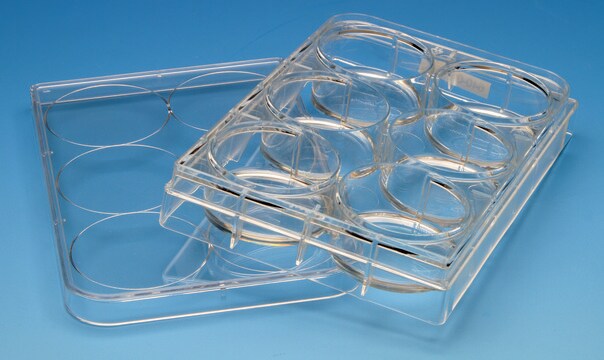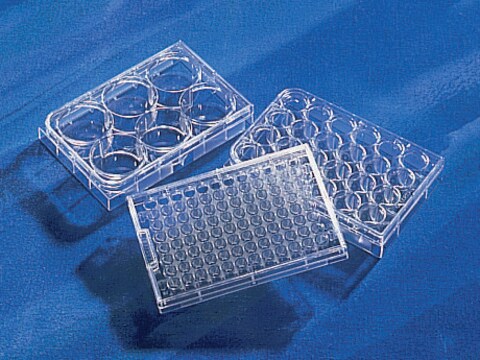CC311
CytoSoft® Imaging 24-Well Plate
Elastic Moduli 32 kPa
Iniciar sesiónpara Ver la Fijación de precios por contrato y de la organización
About This Item
UNSPSC Code:
12352207
NACRES:
NB.15
Productos recomendados
General description
The rigidity of the cell′s substrate (such as the extracellular matrix) can have a profound effect on cell function including morphology, differentiation and gene expression. Young′s elastic modulus is a mechanical property that measures the stiffness of a solid material. It defines the relationship between stress and strain in a material and is measured in kPa.
CytoSoft® plates provide a tool to culture cells on substrates with defined rigidities covering a broad physiological range (0.2 kPa- 64 kPa). On the bottom of each well, there is a thin layer of specially formulated biocompatible silicone, whose elastic modulus (rigidity) is carefully measured and certified. The surfaces of the gels are functionalized to form covalent bonds with amines on proteins. The gel readily binds to purified ECM proteins, such as PureCol type I collagen (5006), prior to cell addition.
CytoSoft® Imaging plates are designed for high-resolution imaging where low autofluorescence and exceptional optical clarity are required. These plates accommodate both live cell imaging and common fixation techniques such as immunostaining. Plate consists of a 175 μm thin polycarbonate film-bottom plate bonded with a black polystyrene frame and includes a lid. The plates are sterilized using ozone and provided with 1 plate per package.
Note: Use these recommendations as guidelines to determine the optimal coating conditions for your culture system. The bottom of the plate can be detached by excessive mechanical force such as centrifugation or direct contact with liquid handling tools (tips, pipettes, etc.).
1. Remove the CytoSoft® product from the protective sleeve in a sterile hood.
2. Prepare extracellular matrix material by neutralizing in amine-free buffer pH 7.4 to 7.9 (such as 1X DPBS). We do not recommend using gelatin as your ECM protein. Note: Pre-warm the coating solution to approximately room temperature before use.
3. Dilute as needed, and dispense 1 mL of solution into each well to coat the surface. Note: Recommended dilution for PureCol Type I collagen is 1:30 (~100 μg/ml). Note: The hydrophobic surface requires larger volumes to cover the surface than do conventional plastic dishes
4. Incubate ECM coated CytoSoft® at room temperature, covered for 1 hour.
5. After incubation, aspirate any remaining material and rinse coated surfaces immediately two times with culture medium or PBS. Leave about 2.5 mL of medium per well to keep surface covered.Note: Do not allow the CytoSoft® surface to become dry once the surface has been wetted.
6. Coated surfaces are ready for use. Standard harvesting procedures used for removing cells from cultureware can be employed for harvesting cells from the CytoSoft® product including use of trypsin, Accutase and non-enzymatic cell detachment solutions.
CytoSoft® is a registered trademark of Advanced BioMatrix, Inc.
CytoSoft® plates provide a tool to culture cells on substrates with defined rigidities covering a broad physiological range (0.2 kPa- 64 kPa). On the bottom of each well, there is a thin layer of specially formulated biocompatible silicone, whose elastic modulus (rigidity) is carefully measured and certified. The surfaces of the gels are functionalized to form covalent bonds with amines on proteins. The gel readily binds to purified ECM proteins, such as PureCol type I collagen (5006), prior to cell addition.
CytoSoft® Imaging plates are designed for high-resolution imaging where low autofluorescence and exceptional optical clarity are required. These plates accommodate both live cell imaging and common fixation techniques such as immunostaining. Plate consists of a 175 μm thin polycarbonate film-bottom plate bonded with a black polystyrene frame and includes a lid. The plates are sterilized using ozone and provided with 1 plate per package.
Note: Use these recommendations as guidelines to determine the optimal coating conditions for your culture system. The bottom of the plate can be detached by excessive mechanical force such as centrifugation or direct contact with liquid handling tools (tips, pipettes, etc.).
1. Remove the CytoSoft® product from the protective sleeve in a sterile hood.
2. Prepare extracellular matrix material by neutralizing in amine-free buffer pH 7.4 to 7.9 (such as 1X DPBS). We do not recommend using gelatin as your ECM protein. Note: Pre-warm the coating solution to approximately room temperature before use.
3. Dilute as needed, and dispense 1 mL of solution into each well to coat the surface. Note: Recommended dilution for PureCol Type I collagen is 1:30 (~100 μg/ml). Note: The hydrophobic surface requires larger volumes to cover the surface than do conventional plastic dishes
4. Incubate ECM coated CytoSoft® at room temperature, covered for 1 hour.
5. After incubation, aspirate any remaining material and rinse coated surfaces immediately two times with culture medium or PBS. Leave about 2.5 mL of medium per well to keep surface covered.Note: Do not allow the CytoSoft® surface to become dry once the surface has been wetted.
6. Coated surfaces are ready for use. Standard harvesting procedures used for removing cells from cultureware can be employed for harvesting cells from the CytoSoft® product including use of trypsin, Accutase and non-enzymatic cell detachment solutions.
CytoSoft® is a registered trademark of Advanced BioMatrix, Inc.
Storage and Stability
Store CytoSoft Imaging plates at room temperature.
Legal Information
CytoSoft is a registered trademark of Advanced BioMatrix, Inc.
Disclaimer
Unless otherwise stated in our catalog or other company documentation accompanying the product(s), our products are intended for research use only and are not to be used for any other purpose, which includes but is not limited to, unauthorized commercial uses, in vitro diagnostic uses, ex vivo or in vivo therapeutic uses or any type of consumption or application to humans or animals.
Storage Class
13 - Non Combustible Solids
wgk_germany
nwg
flash_point_f
Not applicable
flash_point_c
Not applicable
Certificados de análisis (COA)
Busque Certificados de análisis (COA) introduciendo el número de lote del producto. Los números de lote se encuentran en la etiqueta del producto después de las palabras «Lot» o «Batch»
¿Ya tiene este producto?
Encuentre la documentación para los productos que ha comprado recientemente en la Biblioteca de documentos.
Nuestro equipo de científicos tiene experiencia en todas las áreas de investigación: Ciencias de la vida, Ciencia de los materiales, Síntesis química, Cromatografía, Analítica y muchas otras.
Póngase en contacto con el Servicio técnico


